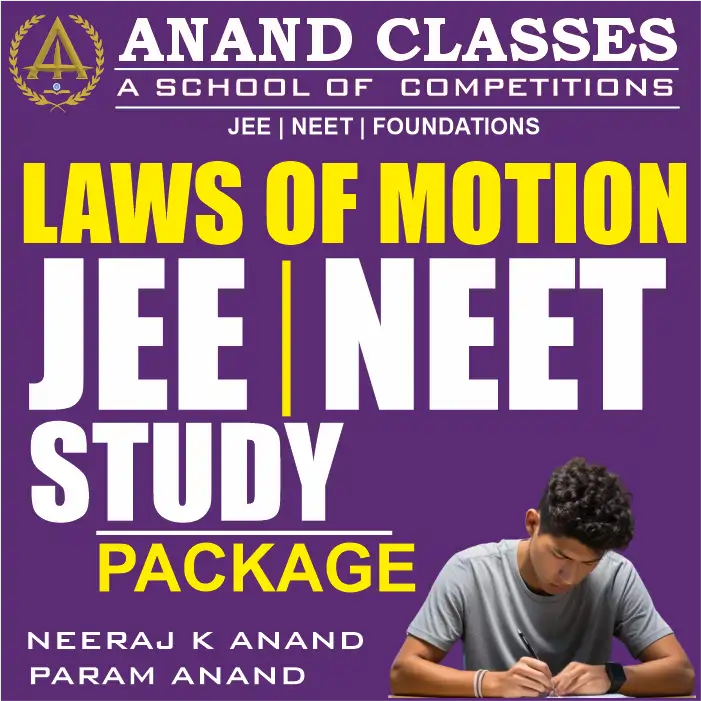Friction Notes With JEE NEET MCQS Physics Class 11 CBSE Study Material Full Chapter Download pdf-Anand Classes
What Is Friction?
Friction is defined as the resistance offered by the surfaces that are in contact when they move past each other.
Friction provides traction that is needed to walk without slipping. Friction is helpful in most cases. However, they also offer a great measure of opposition to the motion. In addition, about 20 per cent of the engine power of automobiles is consumed in overcoming frictional forces in the moving parts. In the next section, let us go through some of these factors.
Factors Affecting Friction
Friction is a force that is dependent on external factors. Following are the two factors on which friction depends:
| 1. On the nature of the two surfaces that are in contactFriction is dependent on the smoothness or roughness of the two surfaces that are in contact with each other. When the surface is smooth, the friction between the two reduces as there is not much interlocking of irregularities. While the surface is rough, friction increases. |
| 2. On the force that is acting on these surfacesFriction increases when the force is applied along with the irregularities. |
What Causes Friction?
Friction is caused due to the irregularities on the two surfaces in contact. So, when one object moves over the other, these irregularities on the surface get entangled, giving rise to friction. The more the roughness, the more irregularities and more significant will be the friction.
Types of Friction
There are four types of friction and they are classified as follows:
- Static friction
- Sliding friction
- Rolling friction
- Fluid friction
All four types of frictions are different from each other. For example, static friction is the friction that acts between the surfaces when they are at rest with respect to each other. In contrast, sliding friction is the resistance created between any two objects when sliding against each other.
Applications of Friction
- Friction finds application when matchsticks are ignited.
- Motion of pistons in a cylinder is an application of friction.
- It is possible to write on books and board as there is friction between pen and the board.
- Fluid friction
- Lubricated friction
- Skin friction
- Internal friction
- Dry friction
- Kinetic friction
- Static friction
What is Static Friction?
Static friction is a force that keeps an object at rest. Static friction definition can be written as:
The friction experienced when individuals try to move a stationary object on a surface, without actually triggering any relative motion between the body and the surface on which it is on.
It can be explained as the force of friction which precisely balances the applied force for the duration of the stationary state of the body.
The static frictional force is self-regulating, i.e. static friction will at all times be equivalent and opposite to the force applied.
R is the reaction force because of the weight W. The external force is F, and fr is the friction. F = -fr when no motion takes place.
Static Friction Examples
Some real-life examples of static friction are given in the points below.
- Papers on a tabletop
- A towel hanging on a rack
- A bookmark in a book
- A car parked on a hill
Laws of Static Friction
- The maximum force of static friction is not dependent on the area of contact.
- The maximum force of static friction is comparative to the normal force i.e., if the normal force increases, the maximum external force that the object can endure without moving, also increases.
Limiting Friction:
It is the highest value of static friction which comes into play when an object is just about to slide over the surface of a different object. For an exerted external force greater than the limiting friction, the body begins to move.
Once the motion has started, static friction cannot be considered. A new type of friction termed as kinetic friction comes into play.
Laws of Limiting Friction:
- The direction of limiting frictional force is always contrary to the direction of motion.
- Limiting friction acts tangentially to the two surfaces interacting.
- The magnitude of limiting friction is proportional to the normal reaction between the two surfaces.
- The limiting friction hinges upon the material, the nature of the surfaces interacting and their evenness.
- So long as the normal reaction is the same, the magnitude of limiting friction is free of the shape or the area of the surfaces in contact for any two given surfaces.
What Are the Laws of Friction?
There are five laws of friction and they are:
- The friction of the moving object is proportional and perpendicular to the normal force.
- The friction experienced by the object is dependent on the nature of the surface it is in contact with.
- Friction is independent of the area of contact as long as there is an area of contact.
- Kinetic friction is independent of velocity.
- The coefficient of static friction is greater than the coefficient of kinetic friction.
The laws of friction for two bodies in contact with each other are given as follows:
- If the two bodies in contact with each other are slipping over each other, or having relative motion with respect to each other, the friction that is involved is kinetic friction and is given by Fk = μk N
- where,
- fk = kinetic friction
- µk = coefficient of kinetic friction
- N = Normal reaction force
- The direction of this kinetic friction on a body is opposite to the direction of the relative velocity of the body with respect to the other body.
Suppose body A moves over body B in the positive x-direction, then the kinetic frictional force on body A will act in the negative x-direction.
- If the bodies do not have relative motion with respect to each other, the friction between them is static friction and is always less than or equal to the kinetic friction. It is important to remember that the value of static friction is not constant, as the case is with kinetic friction. The value of static friction depends on how much force is applied to the body. Suppose the maximum value of static friction (limiting friction) is 5 N for a body kept on a certain surface. If you apply a force of 2 N on the body, the value of static friction would be 2 N, and the body will not move. The body will start moving when the force crosses the values of 5 N.
- The kinetic frictional force and the static frictional force do not depend on the area of contact as long as the Normal Reaction force is the same.
- The maximum value of static friction is achieved when the body is just on the verge of motion. The friction at this point is also known as limiting friction. Limiting friction is always slightly greater than the kinetic friction and is given by:
- fmax = µs N
- where,
- fmax = limiting friction
- µs = coefficient of static friction
- N = Normal reaction force
- The direction of this kinetic friction on a body is opposite to the direction of the relative velocity of the body with respect to the other body.
If we consider only the rotational motion, then point B tends to move backwards suppose with a velocity VR. Similarly, we consider only linear motion then point B moves with a velocity VL in the forward direction. Now the resultant motion of the point B will be a superposition of both the above velocities. Depending upon the values of VR and VL the rolling friction can act in the following directions:
If VR > VL then the point B tends to move backwards so as we know, friction opposes relative motion between the surfaces in contact; hence it will act in the forward direction.
imilarly, if VR < VL then the point B tends to move forward and hence the friction acts in the backward direction.
Also, if VR = VL although the ball moves in the forward direction, the frictional force acting on the ball will be zero. This is unlike sliding friction where the friction force will definitely act if the body is moving.
Types Of Friction
Following are the friction types which depend on the types of motion:
- Static Friction
- Sliding Friction
- Rolling Friction
- Fluid Friction
Static Friction
Static friction is defined as the frictional force that acts between the surfaces when they are at rest with respect to each other.
The magnitude of the static force is equal in the opposite direction when a small amount of force is applied. When the force increases, at some point maximum static friction is reached.
Static Friction Examples
Following are the examples of static friction:
- Skiing against the snow
- Creating heat by rubbing both the hands together
- Table lamp resting on the table
Coefficient Of Static Friction
The coefficient of static friction is denoted as µs. The maximum force of static friction is given as the product of the coefficient of static friction and normal force and force of static friction is less than or equal to the product of the coefficient of static friction and normal force. It is given as:
| Fs max = µs η and Fs ≤ µs η |
Where,
- Fs is the force of static friction
- µs is the coefficient of static friction
- η is the normal force
- Fs max is the maximum force of static friction
Sliding Friction
What Is Sliding Friction?
Sliding friction is defined as the resistance that is created between any two objects when they are sliding against each other.
Examples Of Sliding Friction
Following are the examples of sliding friction:
- Sliding of the block across the floor
- Two cards sliding against each other in a deck
Coefficient Of Sliding Friction
The coefficient of sliding friction is denoted as µs. The force of sliding friction is defined as the product of the coefficient of sliding friction and the normal force. It is given as:
| Fs = µs. Fn |
Rolling Friction
What Is Rolling Friction?
Rolling friction is defined as the force which resists the motion of a ball or wheel and is the weakest types of friction.
Examples Of Rolling Friction
Following are the examples of rolling friction:
- Rolling of the log on the ground
- Wheels of the moving vehicles
Coefficient Of Rolling Friction
The coefficient of rolling friction is denoted as µr. The force of rolling friction is defined as the product of the coefficient of rolling friction and the normal force. It is given as:
| Fs = µr. Fn |
Fluid Friction
What Is Fluid Friction?
Fluid friction is defined as the friction that exists between the layers of the fluid when they are moving relative to each other.
Examples Of Fluid Friction
Following are the examples of fluid friction:
- The flow of ink in pens
- Swimming
Frequently Asked Questions – FAQs
How does friction produce heat?
How is friction useful?
Why is friction a non-conservative force?
Will friction increase as the speed increases?
Can friction be zero?
What is static friction?
What is sliding friction?
Define rolling friction.
What is fluid friction?
Give two examples of sliding friction.
What is static friction?
What is sliding friction?
Is frictional force a scalar or a vector?
How does friction produce heat?
What is the formula to calculate the frictional force?
Where μs is the coefficient of static friction and N is the normal reaction between the two contact surfaces.
Keywords
friction notes class 8, friction notes class 8 pdf, friction notes class 11, friction notes pdf, friction notes class 11 pdf download, friction notes jee, friction notes in hindi, friction notes class 8th, friction notes class 8 ncert, friction notes class 9, friction jee mains questions, friction jee advanced questions, friction jee notes, friction jee, friction jee notes pdf, friction jee pyqs, friction jee formula sheet, friction jee advanced pyq, friction jee advanced notes, friction jee formulas, friction notes class 8, friction notes class 8 pdf, friction notes class 11, friction notes pdf, friction notes class 11 pdf download, friction notes jee, friction notes in hindi, friction notes class 8th, friction notes class 8 ncert, friction notes class 9, friction jee mains questions, friction jee advanced questions, friction jee notes, friction jee, friction jee notes pdf, friction jee pyqs, friction jee formula sheet, friction jee advanced pyq, friction jee advanced notes, friction jee formulas, friction neet questions, friction neet questions with solutions, friction neet pyqs, friction neet notes, friction neet questions with solutions pdf, is neet exam tough, is neet tough, which material is best for neet, fluid mechanics neet syllabus


































